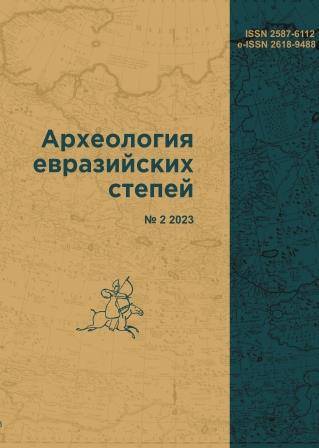East Component in the Bronze Age and Early Iron Age Materials of the Middle and Lower Sukhona
DOI:
https://doi.org/10.24852/2587-6112.2023.2.72.85Keywords:
archaeology, Vologda Region, Bronze Age, Early Iron Age, Sukhona River, ceramicsAbstract
The relative chronology of events in the Bronze Age in the north of the forest belt was outlined
by S.V. Oshibkina, who identified the Late Kargopol culture in the Eastern Onega and the Sukhona basins of the middle of the II millennium BC – the middle of the I millennium BC, formed on a local Neolithic basis with the participation of small groups of the southern population. Studies of the last 30 years allow author to identify significant eastern / south-eastern components in the cultural genesis of the ancient population of the Middle and Lower Sukhona, which is associated with the nature of the hydrological network of this region. The southeastern component is associated with the spread of the Middle Volga Chirki archaeological culture into the Sukhona basin in the Middle Bronze Age and the spread / formation (?) pottery tradition, close to the Lebyazhskaya archaeological culture of the Northern Urals in the Late Bronze Age. In the Early Iron Age the spread of the Ananyino appearance ceramics with corded and comb-corded ornamentation throughout the river includes the Sukhona basin in the Ananyino cultural and historical area. This paper presents materials of the Bronze Age and the Early Iron Age from the sites of the Middle and Lower Sukhona studied by the author. For the first time, materials of the Motyri-1 settlement (Loshechnaya) with a ceramic assemblage close to the Lebyazhskaya culture are put into the scientific circulation. Scientists see the basis for the formation of the northern Ananyino population in the Lebyazhskaya culture. The description of materials is accompanied by mapping of objects with ceramics of the Chirki, Lebyazhskoye and Ananyino appearance.
References
Andrianova, L. S., Ivanishcheva, M. V. 1998. In Chernykh, I. N. (ed.). Tverskoi arkheologicheskii sbornik (Tver Archaeological Volume of Papers) 3. Tver: Tver State United Museum, 308–323 (in Russian).
Vasil’ev, S. Yu. 1996. In Bashen’kin, A. N., Shumkin, V. Ya. (eds.). Drevnosti Russkogo Severa (Antiquities of the Russian North). Vologda: “Ardvisura” Publ., 94–102 (in Russian).
Voronin, K. V. 1998. In Chernykh, I. N. (ed.). Tverskoi arkheologicheskii sbornik (Tver Archaeological Volume of Papers) 3. Tver: Tver State United Museum, 308–323 (in Russian).
Denisov, V. P., Mel’nichuk, A. F., Treskov, S. A. 2012. In Belavin, A. M. (ed.). Trudy Kamskoi arkheologo-etnograficheskoi ekspeditsii (Proceedings of the Kama Archaeological and Ethnographical Expedition) VIII. Perm: Perm State Humanitarian Pedagogical University, 115–121 (in Russian).
Zhul’nikov, A. M. 2005. Poseleniia epokhi rannego metalla Iugo-Zapadnogo Pribelomor'ia (Settlements of the Early Metal Age of the South-Western White Sea Region). Petrozavodsk: “Paritet: Publ. (in Russian).
Zhul’nikov, A. M. 2022. In Povolzhskaya arkheologiya (Volga River Region Archaeology) 41 (3), 188–203 (in Russian).
Zhul’nikov, A. M. 2021. In Chernykh, I. N. (ed.). Tverskoi arkheologicheskii sbornik (Tver Archaeological Volume of Papers) 12. Tver: “Triada” Publ., 77–92 (in Russian).
Ivanishcheva, M. V. 2012. In Kudryashov, A. V. (ed.). Arkheologiya Severa (Archaeology of the North) 4. Cherepovets: “Grafitti” Publ., 33–53 (in Russian).
Ivanishcheva, M. V. 2020. In Martynov, A. Ya. (ed.). Belomor'e i prilegayushchie territorii: istoriya i kul'tura s drevneyshikh vremen do nashikh dney (White Sea region and adjacent territories: history and culture from ancient times to the present day). Arkhangelsk: “Lotsiia” Publ., 70–78 (in Russian).
Ivanishcheva, M. V. 2022. In Solovki v istorii i kul'ture russkogo Severa (Solovki in the history and culture of the Russian North) (in print) (in Russian).
Ivanishheva, E. 1999. In Sablin, V. A. (ed. in chief.). Izvestiya Vologodskogo obshhestva izucheniya Severnogo kraya (Bulletin of the Vologda Society for Northern Territory Studies) 6. Vologda: “Legiya” Publ., 81–83 (in Russian).
Kuzminykh, S. V. 1983. Metallurgiia Volgo-Kam’ia v rannem zheleznom veke (med’ i bronza) (Metallurgy of the Volga-Kama Region in the Early Iron Age (Copper and Bronze)). Moscow: “Nauka” Publ. (in Russian).
Kuzminykh, S. V. 2011. In Kratkie soobshcheniia Instituta arkheologii (Brief Communications of the Institute of Archaeology) 225 (1), 240–263 (in Russian).
Lyganov, A. V. 2021. In Sitdikov, A. G., Chizhevsky, A. A. (eds.). Eneolit i bronzovyi vek (Eneolithic and Bronze Age). Series: Arkheologiia Volgo-Uralia (Archaeology of the Volga-Urals) Vol. 2. Kazan: Institute of Archaeology named after A. Kh. Khalikov, Tatarstan Academy of Sciences, 522–547 (in Russian).
Novikov, A. V., Nedomolkina, N. G. 2021. In Chernykh, I. N. (ed.). Tverskoi arkheologicheskii sbornik (Tver Archaeological Volume of Papers) 12. Tver: “Triada” Publ., 353–374 (in Russian).
Oshibkina, S. V. 1987. In Bader, O. N., Krainov, D. A., Kosarev, M. F. (eds.). Epokha bronzy lesnoi polosy SSSR (The Bronze Age in the Forest Zone of the USSR). Series: Archaeology of the USSR 8. Moscow: “Nauka” Publ., 147–156 (in Russian).
Stavitsky, V. V., Solov’ev, B. S. 2021. In Sitdikov, A. G., Chizhevsky, A. A. (eds.). Eneolit i bronzovyi vek (Eneolithic and Bronze Age). Series: Arkheologiia Volgo-Uralia (Archaeology of the Volga-Urals) Vol. 2. Kazan: Institute of Archaeology named after A. Kh. Khalikov, Tatarstan Academy of Sciences, 469–482 (in Russian).
Chernykh, E. M., Chizhevsky, A. A. 2021. In Sitdikov, A. G., Chizhevsky, A. A. (eds.). Rannii zheleznyi vek (Early Iron Age). Series: Arkheologiia Volgo-Uralia (Archaeology of the Volga-Urals) Vol. 3. Kazan: Institute of Archaeology named after A. Kh. Khalikov, Tatarstan Academy of Sciences, 217–241 (in Russian).

Downloads
Published
How to Cite
Issue
Section
License
Copyright (c) 2023 M.V. Ivanishcheva

This work is licensed under a Creative Commons Attribution-NonCommercial 4.0 International License.







